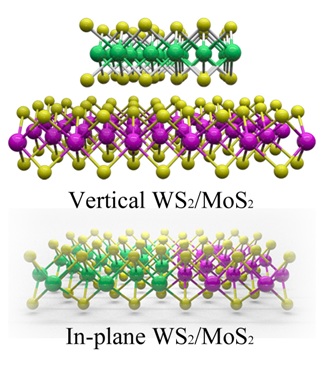Oct 1 2014
A little change in temperature makes a big difference for growing a new generation of hybrid atomic-layer structures, according to scientists at Rice University, Oak Ridge National Laboratory, Vanderbilt University and Pennsylvania State University.
 Stacked (top) and in-plane nanomaterials self-assemble in two ways, depending on the temperature at which they’re grown, according to Rice University researchers who led the project. The semiconducting materials show promise for a new generation of “pixel” electronics. In the illustration, green spheres are tungsten, purple are molybdenum and yellow are sulfur. (Credit: Ajayan Group/Rice University)
Stacked (top) and in-plane nanomaterials self-assemble in two ways, depending on the temperature at which they’re grown, according to Rice University researchers who led the project. The semiconducting materials show promise for a new generation of “pixel” electronics. In the illustration, green spheres are tungsten, purple are molybdenum and yellow are sulfur. (Credit: Ajayan Group/Rice University)
Rice scientists led the first single-step growth of self-assembled hybrid layers made of two elements that can either be side by side and one-atom thick or stacked atop each other. The structure’s final form can be tuned by changing the growth temperature.
The discovery reported online this week in Nature Materials could lead to what Rice materials scientist Pulickel Ajayan calls “pixel engineering”: atomically thin semiconductors with no limit to their potential for use in optoelectronic devices.
The researchers led by Ajayan and Wu Zhou, a materials scientist at Oak Ridge, discovered the interesting new composites when they combined the growth of two-dimensional molybdenum disulfide and tungsten disulfide through chemical vapor deposition. In this process, specific gases are heated in a furnace, where their atoms gather in an orderly fashion around a catalyst to form the crystalline material.
High-temperature growth – about 850 degrees Celsius (1,563 degrees Fahrenheit) – yielded vertically stacked bilayers, with tungsten on top. At lower temperatures, about 650 degrees C (1,202 degrees F), the crystal lattices preferred to grow side by side. The interfaces in either material are sharp and clean, as seen under a scanning electron microscope and in spectroscopic studies.
“With the advent of 2-D layered materials, people are trying to build artificial structures using graphene and now dichalcogenides as building blocks,” Ajayan said. Because graphene is atomically thin and flat and dichalcogenides like molybdenum disulfide are not quite that flat, there is some incompatibility when these are grown together — but two dichalcogenides with different compositions could be compatible. “We show that depending on the conditions, we can combine two dichalcogenides to grow either in-plane hybrid or in stacks.”
The monolayer composites have small but stable band gaps, while the stacked composite layers show modified electronic properties such as enhanced photoluminescence, which will be useful for electronics that rely on optical signals.
“What’s even more interesting is that the layered structure has a particular lock-in stacking order,” Zhou said. “When you stack 2-D materials by transferring layers, there’s no way to control their orientation to one another. That impacts their electronic properties. In this paper, we demonstrate that in a certain window, we can get a particular stacking order during growth, with a particular orientation.”
The new materials could be used for vertically stacked field-effect transistors as well as electronic devices only a few atoms thick, he said.
“We should be able to tweak certain regions to control certain functions, like light or terahertz emission,” said Robert Vajtai of Rice, a co-author of the study. “The whole idea, really, is to create domains with different electronic characters within a single layer.”
“Our goal is to build fully functional electronic devices on a single plane, or maybe a few layers,” added Mauricio Terrones, a co-author from Penn State. “What we’ve accomplished means that pretty much any architecture for devices is now possible on a single atomic layer. And that’s remarkable.”
Co-authors are graduate students Yongji Gong, Gang Shi, Sidong Lei and Gonglan Ye and postdoctoral researcher Xiaolong Zou; Jun Lou, an associate professor and associate department chair of materials science and nanoengineering; and Boris Yakobson, the Karl F. Hasselmann Professor of Materials Science and NanoEngineering and a professor of chemistry, all of Rice; Junhao Lin and Sokrates Pantelides of Oak Ridge and Vanderbilt University; Xingli Wang, Beng Kang Tay and Zheng Liu of Nanyang Technological University, Singapore; graduate student Zhong Lin of Pennsylvania State University; and Humberto Terrones, the Rayleigh Endowed Chair Professor of Physics at Rensselaer Polytechnic Institute.
Vajtai is a faculty fellow at Rice. Mauricio Terrones is a professor of physics, chemistry, materials science and engineering at Penn State. Ajayan is Rice’s Benjamin M. and Mary Greenwood Anderson Professor in Mechanical Engineering and Materials Science and of chemistry and chair of the Department of Materials Science and NanoEngineering.
The Army Research Office, the Department of Energy, the National Science Foundation, the Microelectronics Advanced Research Corp., the Defense Advanced Research Projects Agency, the U.S. Office of Naval Research and the Ministry of Education Academic Research Fund and Silicon Technologies Center of Excellence, Singapore, supported the research.